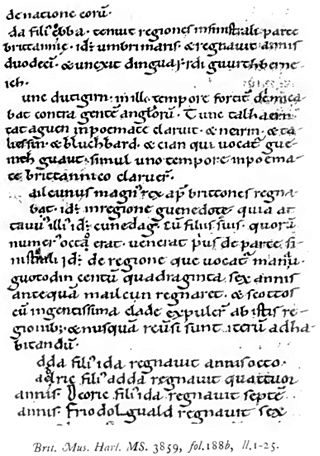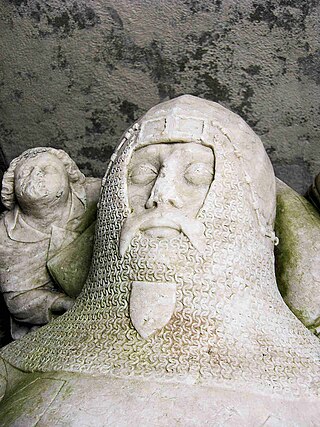Related Research Articles

Cunedda ap Edern, also called Cunedda Wledig, was an important early Welsh leader, and the progenitor of the Royal dynasty of Gwynedd, one of the very oldest of Western Europe.

The Black Book of Carmarthen is thought to be the earliest surviving manuscript written solely in Welsh. The book dates from the mid-13th century; its name comes from its association with the Priory of St. John the Evangelist and Teulyddog at Carmarthen, and is referred to as black due to the colour of its binding. It is currently part of the collection of the National Library of Wales, where it is catalogued as NLW Peniarth MS 1.
Hywel ab Owain Gwynedd, Prince of Gwynedd in 1170, was a Welsh poet and military leader. Hywel was the son of Owain Gwynedd, prince of Gwynedd, and an Irishwoman named Pyfog. In recognition of this, he was also known as Hywel ap Gwyddeles. Hywel is also known as the Poet Prince for his bardic skills.

Brycheiniog was an independent kingdom in South Wales in the Early Middle Ages. It allied with the Mercian kingdom in the post Roman era, to stabilise and control a central (Marches) area key to dominance over central Proto-England to the east and the south Welsh kingdom of Deheubarth to the west. It was conquered and pacified by the Armorican Normans between 1088 and 1095, though it remained Welsh in character. It was transformed into the Lordship of Brecknock and later formed the southern and larger part of the historic county of Brecknockshire. To its south was the Kingdom of Morgannwg.
Cuneglasus was a prince of Rhos in Gwynedd, Wales, in the late 5th or early 6th century. He was castigated for various sins by Gildas in De Excidio Britanniae. The Welsh form Cynlas Goch is attested in several genealogies of the Rhos royal line. The two names are assumed to refer to the same ruler.
Ieuan ab Owain Glyndŵr was reputedly the illegitimate son of the last native Welsh Prince of Wales; Owain Glyndŵr. The possibility of his existence was uncovered through the work of Peter Bartrum which is currently being edited by the University of Wales Aberystwyth. Ieuan ab Owain and his descendants are detailed in Peniarth Manuscript 287 in the hand of Robert Vaughan of Hengwrt (c.1592-1667) and also in the manuscript known as Harley 1969 by Griffith Hughes (1634–1665) - the original manuscripts are kept at the National Library of Wales, Aberystwyth and the British Library respectively.
Peter Clement Bartrum was a researcher and genealogist who, from the 1930s onwards, specialised in the genealogy of the Welsh nobility of the Middle Ages.

Ial or Yale was a commote of medieval Wales within the cantref of Maelor in the Kingdom of Powys. When the Kingdom was divided in 1160, Maelor became part of the Princely realm of Powys Fadog, and belonged to the Royal House of Mathrafal. Yale eventually merged with another commote and became the Lordship of Bromfield and Yale, later a royal lordship under the Tudors and Stuarts.

The Royal House of Mathrafal began as a cadet branch of the Welsh Royal House of Dinefwr, taking their name from Mathrafal Castle. They effectively replaced the House of Gwertherion, who had been ruling the Kingdom of Powys since late Roman Britain, through the politically advantageous marriage of an ancestor, Merfyn the Oppressor. King Bleddyn ap Cynfyn would join the resistance of the Anglo-Saxon King Harold Godwinson, against the invasion of William the Conqueror, following the Norman conquest of England. Thereafter, they would struggle with the Plantagenets and the remaining Welsh Royal houses for the control of Wales. Although their fortunes rose and fell over the generations, they are primarily remembered as Kings of Powys and last native Prince of Wales.

Anwyl of Tywyn are a Welsh family who claim a patrilinear descent from Owain Gwynedd, King of Gwynedd from 1137 to 1170 and a scion of the royal House of Aberffraw. The family motto is: Eryr eryrod Eryri, which translates as "The Eagle of the Eagles of Snowdonia. The family lives in Gwynedd and speak Welsh.
Rhirid Flaidd, according to Welsh tradition, was the son of Gwrgenau, who is supported by an obscure pedigree going back to Cunedda Wledig, the progenitor of the House of Cunedda which had provided the kings of Gwynedd from the end of Roman Britain until 825. The appellation of blaidd (wolf) was inherited from his maternal grandmother, Haer, daughter and heiress of Cynfyn, son of Cillyn y Blaidd Rhudd of Gest in Eifionydd. He was related through his grandmother to Bleddyn ap Cynfyn, king of Powys who rewarded Gwrgenau with land, presumably for his loyalty and service.

The Harleian genealogies are a collection of Old Welsh genealogies preserved in British Library, Harley MS 3859. Part of the Harleian Library, the manuscript, which also contains the Annales Cambriae and a version of the Historia Brittonum, has been dated to c. 1100, although a date of c.1200 is also possible.
The genealogies from Jesus College MS 20 are a medieval Welsh collection of genealogies preserved in a single manuscript, Oxford University, Bodleian Library, Jesus College, MS 20, folios 33r–41r. It presents the lineages of a number of medieval Welsh rulers, particularly those of south Wales. The manuscript was compiled in the late 14th century, but many genealogies are thought to be considerably older. The latest pedigrees to have been included in the tract are those of Llywelyn ab Iorwerth and Rhys Gryg. It shares some material with the earlier Harleian genealogies.
Philip Yorke was a Welsh politician who sat in the House of Commons between 1775 and 1792 and an antiquary who developed an interest in Welsh history and genealogy relatively late in life. He was the author of The Royal Tribes of Wales (1799).

Rhys Mechyll was a Welsh prince, Lord of Dinefwr, of the House of Dinefwr and Kingdom of Deheubarth in southern Wales from 1234 to 1244. He was a son of prince Rhys Gryg, son of prince Rhys ap Gruffydd (1132–1197), "The Lord Rhys", ruler of the kingdom of Deheubarth.

Tudur ap Goronwy was a Welsh landowner, soldier and administrator of the Tudors of Penmynydd family from the island of Anglesey.
The Baronetcy of Ellis-Nanney of Gwynfryn and Cefndeuddwr was granted to Hugh Ellis-Nanney in 1898. The 1st baronet was a landowner with over 12,000 acres in North Wales, UK, most of which was inherited from his father, Owen Jones Ellis-Nanney. The family were political Conservative party members within the parliamentary constituency of Caernarfon, Wales.
Amlawdd Wledig was a legendary king of sub-Roman Britain. The Welsh title [G]wledig, archaically Gwledic or Guletic and Latinised Guleticus, is defined as follows: "lord, king, prince, ruler; term applied to a number of early British rulers and princes who were prominent in the defence of Britain about the time of the Roman withdrawal; (possibly) commander of the native militia ".
References
- Siddons, Michael (2006). "Genealogies [2] Welsh". In Koch, John T. (ed.). Celtic Culture: A Historical Encyclopedia. Santa Barbara, Denver, and Oxford: ABC-CLIO. pp. 800–2.
- Bartrum, Peter C. (1962). "Hen Lwythau Gwynedd a'r Mars". National Library of Wales Journal . 12: 201–235.